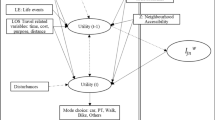Abstract
The empirical valuation of travel time savings is a derivative of the ratio of parameter estimates in a discrete choice model. The most common formulation (multinomial logit) imposes strong restrictions on the profile of the unobserved influences on choice as represented by the random component of a preference function. As we progress our ability to relax these restrictions we open up opportunities to benchmark the values derived from simple (albeit relatively restrictive) models. In this paper we contrast the values of travel time savings derived from multinomial logit and alternative specifications of mixed (or random parameter) logit models. The empirical setting is urban car commuting in six locations in New Zealand. The evidence suggests that less restrictive choice model specifications tend to produce higher estimates of values of time savings compared to the multinomial logit model; however the degree of under-estimation of multinomial logit remains quite variable, depending on the context.
Similar content being viewed by others
References
Bhat C (1995) A heteroscedastic extreme value model of intercity travel mode choice.Transportation Research29B (6): 471-483.
Bhat C (1997) Recent methodological advances relevant to activity and travel behavior analysis, Conference Pre-prints, IATBR'97, The 8th Meeting of the International Association of Travel Behaviour Research, Austin, Texas, September.
Bhat C (1999) Quasi-random maximum simulated likelihood estimation of the mixed multinomial logit model, Department of Civil Engineering, University of Texas at Austin, Texas.
Brownstone D &; Train K (1999) Forecasting new product penetration with flexible substitution patterns. Journal of Econometrics89 (1-2): 109-129.
Calfee J &; Winston C (1998) The value of automobile travel time: implications for congestion policy. Journal of Public Economics69: 83-102
Daniels R &; Hensher DA (2000) Valuation of environmental impacts of transportation projects: the challenge of self-interest proximity. Journal of Transport Economics and Policy34 (2) (May): 189-214
Hensher DA (1997) A practical approach to identifying the market for high speed rail in the Sydney-Canberra Corridor. Transportation Research31 A(6): 431-446.
Hensher DA, Louviere JJ &; Wallis IP (1999) The valuation of travel time savings for urban and long distance car drivers in New Zealand: recognising the heterogeneity of travel time, report prepared for Booz Allen and Transit New Zealand, Institute of Transport Studies, The University of Sydney, July.
Hensher DA (forthcoming 2000a) The sensitivity of the valuation of travel time savings to the specification of unobserved effects. Transportation ResearchE (Special Issue on Value of Travel Time Savings).
Hensher DA (forthcoming 2000b) Measurement of the valuation of travel time savings. Journal of Transport Economics and Policy(Special Issue in Honour of Michael Beesley).
Hensher DA (2000c) Service Quality as a Package: What does it mean to Heterogeneous Consumers? Institute of Transport Studies, The University of Sydney, June.
Hensher DA, Louviere JJ &; Swait J (1999) Combining sources of preference data. Journal of Econometrics89: 197-221.
Kim KS (1998) Analysing repeated measurement problems in SP data modelling, Paper presented at the 8th World Conference on Transport Research, Antwerp, July (Session D3/05).
Louviere JJ &; Hensher DA (2000) Combining sources of preference data, A Resource Paper for IATBR 2000,9th International Association for Travel Behaviour Research Conference, Gold Coast, Queensland, Australia, 2-7 July, 2000.
Louviere JJ, Hensher DA &; Swait J (2000) Stated choice methods: analysis and applications in marketing, transportation and environmental valuation, Cambridge University Press, Cambridge.
McFadden D &; Train K (forthcoming) Mixed MNL models for discrete response. Applied Econometrics(forthcoming).
Morikawa T (1994) Correcting state dependence and serial correlation in the RP/SP combined estimation method. Transportation21 (2): 153-166.
Revelt D &; Train K (1996) Incentives for appliance efficiency: random parameters logit models for households; choices, Department of Economics, University of California, Berkeley.
Sloan J &; Wozniakowski H (1998) When are quasi-Monte Carlo algorithms efficient for high dimensional integrals? Journal of Complexity14: 1-33.
Train K (1997) Mixed logit models for recreation demand. In: Kling C &; Herriges J (eds) Valuing the Environment Using Recreation Demand Models. New York: Elgar Press.
Train K (1999) Halton sequences for mixed logits, Department of Economics, University of California at Berkeley, August 2.
Author information
Authors and Affiliations
Rights and permissions
About this article
Cite this article
Hensher, D.A. The valuation of commuter travel time savings for car drivers: evaluating alternative model specifications. Transportation 28, 101–118 (2001). https://doi.org/10.1023/A:1010302117979
Issue Date:
DOI: https://doi.org/10.1023/A:1010302117979




